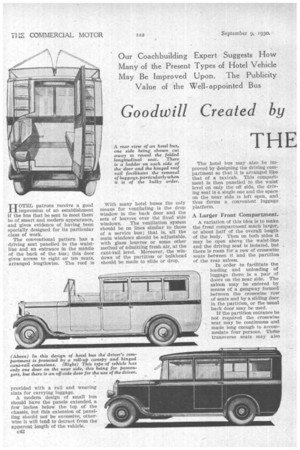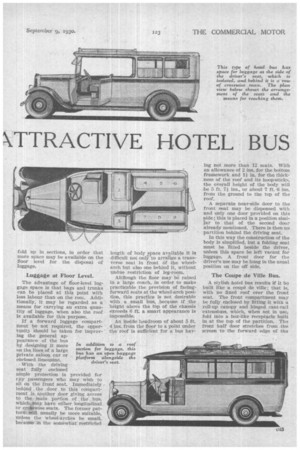Goodwill Created by
Page 64

Page 65

Page 66

If you've noticed an error in this article please click here to report it so we can fix it.
THE \TTRACTIVE HOTEL BUS
Our Coachbuilding Expert Suggests How Many of the Present Types of Hotel Vehicle May Be Improved Upon. The Publicity Value of the Well-appointed Bus
H°TEL patrons receive a good impression of an establishment if the bus that be sent to meet them be of, smart and modern appearance, and gives evidence of having been specially ,designed for its particular class of work.
The conventional pattern has a driving seat panelled to the waistline and an entrance in the middle of the back of the bus; this door gives access to eight -or ten seats, arranged lengthwise. The roof is provided with a rail and wearing slats for carrying luggage.
A modern design of small bus should have the panels extended, a few inches below the top of the chassis, but this extension of panelling should not be excessive, otherwise it will tend to detract from the apparent length of the vehicle.
c42 With many hotel buses the only means for ventilating is the drop window in the back door and the sets of louvres over the fixed side windows. The ventilation system should be on lines similar to those of a service bus; that is, all the main windows should be adjustable, with glass louvres or some other method of admitting fresh air, at the cant-rail level. Moreover, the windows of the partition or bulkhead should be made to slide or drop. The hotel bus may . also be improved by designing the driving compartment so that it is arranged like that of a taxicab. This compartment is then panelled to the waist level on only the off side, the driving seat is a single one and the space on the near side is left open, and thus -forms a convenient luggage platform.
A Larger Front Compartment.
A variation of this idea is to make the front compartment ranch larger, or about half of the overall length of the body. Then on both sides it may •be open above the waist-line and the driving seat is isolated, but there is room for a row of crosswise seats between it -and the partition of the rear saloon.
. In order to facilitate the loading and unloading of luggage there is a pair of doors on the near side. The saloon may be entered by means of a gangway formed between the crosswise row of seats and by a sliding door in the partition, or the usual back door may be used.
• If the partition entrance be not reouired the crosswise seat may be continuous and made long enough to accommodate four persons. These transverse seats may also fold up in sections, in order that more space may be available on the floor level for the disposal of luggage.
Luggage at Floor Level.
The advantage of floor-level luggage space is that bags and trunks can be placed at this point with less labour than on the rooi. Additionally, it may be regarded as a means for carrying an extra quantity of luggage, when also the roof is available for this purpose.
If a forward luggage compartment be not required, the opportunitT, "Should be taken for improving the general appearance of the bus by designing it more on he lines. of .a large private saloon car or enclosed_ limousine.
•
With the driving seat fully enclosed ample protection is provided for apy passengers who may. wish to sit on the front seat. Immediately behind the , door to this compartment is, another door giving access tO the ,rnain portion of . the bus, Whichii.may have 'either longitudinal or cr4swise seats. The former pattern; will usually be more suitable, unless the 'wheel-arches be small, because :in the somewhatrestricted length of body space available it is difficult not onlk-to arrange a transverse seat in front of the wheelarch but also one behind it, without undue restriction of leg-room.
Altfrough the floor may be raised in a large coach, in order to' make practicable the. provision of facing-forward seats at the wheel-arch position, this practice is not desirable with a , small bus, .becauseif the, height above the top of the chassis exceeds 6 ft. a smart appearance is impossible: An inside headroom of about 5 ft. 4 ins, from the floor to a point under the roof is sufficient for a bus hay
ing not more than 12 seats. With an allowance of 2 ins, for the bottom framework and fl in. for the thickness of the roof and its hoop-sticks, the overall height of the body will be 5 ft. 7-i ins., or about 7 ft. ,6 ins. from the ground to the top of the roof.
A separate near-side door to the front seat may be dispensed with and only one door provided on this side; this is placed in a position similar to that of the second dowr already mentioned. There is then no partition behind the driving seat.
In this way the construction of the body is simplified, but a folding seat must be -fitted beside the driver, unless this space be left vacant for luggage. A front door for the driver's use may be hung in the usual position on the off side.
The Coupe de Ville Bus.
A stylish hotel bus results if it be built like a coupe de vine; that is, with no fixed roof over the front seat. The front compartment may be fully. enclosed by fitting it with a rell-up canopy and hinged cant-rail extensions, which, when not in use, fold into a box-like receptacle built in at the top of the partition. The front half door stretches from the screen to the forward edge of the
second door, and it is provided with a pair of extended metal pillars so that a drop or sliding window may be included.
The up-to-date hotel bus usually has a ladder or a set of step treads secured to the off-side rear-corner panel. Step treads may be fixed or hinged, but, although perhaps neater, they are less safe than is a ladder. With a fixed roof rail the trunks have, in order to place them on the roof, to be lifted over this. If easier access to the roof be desired the rail at the hack is hinged, or a metal roller is fitted.
The varieties of small bus which have been described are also suitable• for private-hire work and should prove a valuable addition to the garage fleet. Such a vehicle represents an intermediate size be
tween a large limousine or landaulet and the small service bus.
If the private character of the vehicle be emphasized rather than its luggage-carrying propensities, a 10-seater or 12-seater can he hired for receptions and weddings. It has the advantage that it is cheaper to run than is a couple of landaulets, although it may have the combined capacity of these two cars.












































































































